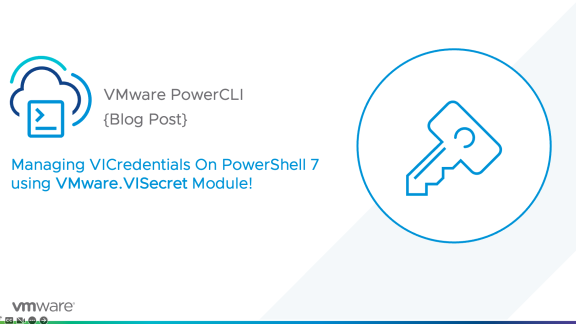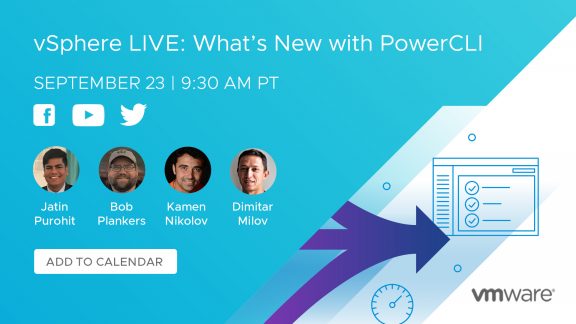There’s been a lot of buzz around PowerCLI lately, and we’re keeping it going! It gives me great pleasure to announce the general availability of VMware PowerCLI 6.5 Release 1!
Before diving in on all the new features, it’s worth noting that these features are all created based on feedback taken directly from the users. Please help us make the product better by letting us know what would make PowerCLI easier to use and what would make your automation tasks less painful! The PowerCLI Product Manager, Development Team and I, would like to extend a huge Thank You to the community for their great feedback and consistent drive to enhance the product.
Cmdlet Updates
The Core vSphere module has received a number of updates as well as stability and performance improvements. The most notable updates include cmdlets based around VM creation and management. The ‘Move-VM’ cmdlet now supports the ability to vMotion VMs between vCenters which is known as Cross vCenter vMotion. Performing a Cross vCenter vMotion with PowerCLI also allows the VM to traverse between separate SSO domains too! This is something not available with the GUI. The ‘New-VM cmdlet now supports configuring a VM to have a specific number of CPU cores. Then, the ‘Open-VMConsoleWindow’ has been updated to provide access to the latest and greatest version of the VMware Remote Console (VMRC). Lastly, various cmdlets have received updated views to allow access to the new vSphere 6.5 APIs!
Storage Module Updates
The PowerCLI Storage module has been a big focus on this release. A lot of functionality has been added around vSAN, VVOLs, and the handling of virtual disks. The vSAN cmdlets have been bolstered to more than a dozen cmdlets which are focused on the entire lifecycle of a vSAN cluster. The entire vSAN cluster creation process can be automated with PowerCLI as well as running tests, updating the HCL database, and much more!
- Get-VsanClusterConfiguration
- Get-VsanDisk
- Get-VsanDiskGroup
- Get-VsanFaultDomain
- Get-VsanResyncingComponent
- Get-VsanSpaceUsage
- New-VsanDisk
- New-VsanDiskGroup
- New-VsanFaultDomain
- Remove-VsanDisk
- Remove-VsanDiskGroup
- Remove-VsanFaultDomain
- Set-VsanClusterConfiguration
- Set-VsanFaultDomain
- Test-VsanClusterHealth
- Test-VsanNetworkPerformance
- Test-VsanStoragePerformance
- Test-VsanVMCreation
- Update-VsanHclDatabase
vSphere 6.5 introduces a new way to handle the management of virtual disks. Instead of managing a VM’s hard disks through the VM, they can now be managed independently with new PowerCLI cmdlets. This allows the handling of a virtual disk’s lifecycle to be decoupled from the lifecycle of a VM. This adds a ton of flexibility!
- Copy-VDisk
- Get-VDisk
- Move-VDisk
- New-VDisk
- Remove-VDisk
- Set-VDisk
PowerCLI has been updated to include new cmdlets that allow for the automated management of the VVOL replication features which are new to vSphere 6.5. Some of the new features include finding fault domains and replication groups, syncing replication groups, as well as preparing for and starting the failover process to the target site.
- Get-SpbmFaultDomain
- Get-SpbmReplicationGroup
- Get-SpbmReplicationPair
- Start-SpbmReplicationFailover
- Start-SpbmReplicationPrepareFailover
- Sync-SpbmReplicationGroup
Horizon Module
A brand-new module has been included to work with VMware Horizon! This has been a long time coming and has finally been released. The module can be installed anywhere and then remotely connect to the Horizon Connection server, a huge improvement over the last offering. Speaking of improvements, the module provides access to 100% of the public API through the Connect-HVServer and Disconnect-HVServer cmdlets. Keep an eye on the PowerCLI-Examples Github repo for functions allowing you to easily work with this module and provide sample code!
Compatibility
As with all versions of PowerCLI, it’s also backwards compatible going back to vSphere 5.5!

The Storage module is compatible with vSAN 6.0 and newer, as well as Site Recovery Manager 6.1 and newer!

Last, the Horizon module is compatible with Horizon 7.0.2.

PowerCLI Core
As if this release wasn’t enough, PowerCLI Core also has support for the new 6.5 vSphere APIs! This ensures those core vSphere cmdlets and Views are available to other operating systems PowerCLI Core operates on as well!
More Information and Download
For more information on changes made in VMware PowerCLI 6.5 Release 1, including improvements, security enhancements, and deprecated features, see the VMware PowerCLI Change Log. For more information on specific product features, see the VMware PowerCLI 6.5 Release 1 User’s Guide. For more information on specific cmdlets, see the VMware PowerCLI 6.5 Release 1 Cmdlet Reference.
You can find the PowerCLI 6.5 Release 1 download HERE. Get it today!



